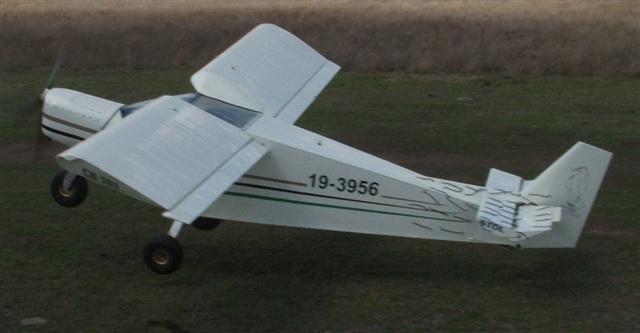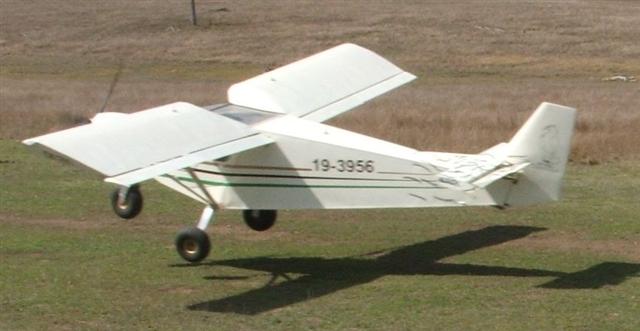New Horizontal Stabilizer for the 701
Lack of
dependable elevator authority when trying to flare for a STOL landing at idle
power has long been a problem for the 701. It’s necessary to hold considerable power right to touch-down in order
to keep elevator authority. Cut the
power and the nose drops suddenly, so you better be right close to the ground.

With power -
The airflow
is still attached cleanly to the top of the horiz stab and deflected up by the
elevator, allowing a high angle of attack for a good STOL landing.

At idle
power -
The airflow
over the top of the horiz stab is detached and turbulent, so the elevator isn’t
getting a clean airflow. Even more upward
elevator deflection than the previous picture, but nowhere near the same AofA.
This photo is with the tail of the 701 held down to the landing
attitude (note the angle of top surface of the horiz stab). The red arrow shows the airflow at idle power,
which tuft testing has shown is parallel to the ground. Now you can see how that ‘inverted airfoil’
becomes a problem. The airflow can’t
remain attached over that sharp corner at the top surface, so goes turbulent as
shown in the above tuft test, and is very disturbed when it reaches the
elevator. The airflow impinging on that
bottom surface is very much deflected downwards, giving an up force on
the tail, which is opposite to what we want.... And with the elevator held full up, as in the landing photos above, the
airflow can’t remain attached to the underside of the elevator to give an
airfoil effect.
This is a
Hans
battled with the limitations of that 701 elevator response for 900 hours. The VGs on the elevator helped greatly, and
the airfoil on the cabin top even helped some, surprisingly. But it still had an inconsistency, whereby,
at idle power, just as he was trying to flare, he would suddenly need full back
stick, and that wouldn’t always be enough for the very slow landing he was
attempting. Here I should mention that
Hans is forever pushing the envelope, and has a whole lot of experience and
expertise at STOL landings, so it certainly wasn’t a lack of skill on his
part.....

The new horizontal stabilizer on Hans' 701.
The Results
The results
are very satisfying! Heaps of elevator
authority at all power settings, including power off. And nice progressive linear control. Never needs anywhere near full up
elevator. He can still drag it on with
power like with the inverted airfloil, but with even better control at less
power. And as a bonus, he gained 3-4 kts
better cruise speed for the same power, as a result of eliminating all the drag
of that original horiz stab. And an
added bonus that can’t really be measured with numbers, it feels like he can
now trim for more stable hands-off cruise.
He’s thrilled with the improvement!
Below are the profiles of the 701 and Savannah horiz stabs. Not hard to see why the Savannah works a lot better, with less drag, eh.......

Looking at the construction of the 701 horiz stab, it looks like you could make a new symmetrical section in place of that inverted airfoil, building on the existing spar. The spar on the horiz stab on the Savannah is 100mm deep, while the 701 is 106mm. Below is the Savannah profile expanded to fit the 701 spar. This drawing was produced by Ron in Winnipeg, and is the pattern he'll use to form the ribs for his modified horizontal stabilizer.

Measuring in mm from the spar, these are the corresponding offsets as shown:
0 - 53
20 - 53
40 - 53
60 - 53
80 - 52.5
100 - 51.5
120 - 50.5
140 - 50
160 - 49
180 - 47.5
200 - 46
220 - 44
240 - 41.5
260 - 39.5
280 - 36.5
300 - 32.5
320 - 20
Nose radius 27mm
You just need to mount the ribs on the spar so that the mean chord line will be 1 degree down at the nose, referenced to the flat area on the underside of the wing just behind the main spar.
The span of the horiz stab spar is the same on the Savannah and the 701, but the Savannah horiz stab and elevator have plastic end caps that extend 100mm each side, but with the rounded shape of these caps, I doubt that they contribute much to the effective area. They are probably mostly for appearance.
The chord of the
Joe has now modified his horizontal stabilizer as above, and is very pleased with the result! He now has plenty of elevator control at all times, and nice progressive control with no surprises.....
......................................................................................................................................................................
'Tail Feathers'
That unique horizontal stabilizer with its inverted airfoil on the 701 looks great in theory, and works well enough with power on, but can’t flare to a high AoA at idle power. That problem has plagued many 701 flyers, especially if they have a forward CofG. And it would be a real problem in an engine-out landing.......
We’ve been working on that problem and have found a very effective fix!
We tried VGs under the 701 horiz stab with moderate success, but then found that the very best effect was to place them near the leading edge of the elevator itself. In this position the VGs are hidden in the slot between the horiz stab and the elevator at cruise, but extend down into the airflow when the elevator is deflected up, as in the flare to a landing. This puts the VGs right in a high velocity airflow, just where they can be most effective.
.JPG)
.JPG)
‘Tail Feathers’ are even more beneficial for all those 701’s still with slats, since more elevator authority is required to pull the high AoA necessary for slats to become really effective.
(Note: Dave was the first to suggest the idea of putting the VGs on the elevator rather than the horiz stab – thanks Dave!)
.............................................................................................................................................................
.................................................................................................................................................................